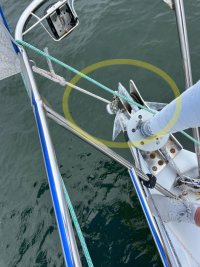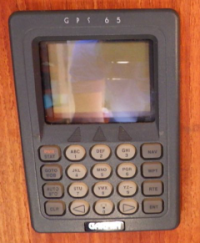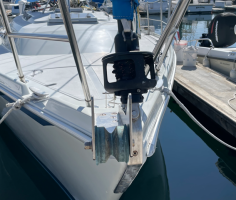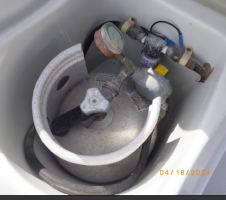You are using an out of date browser. It may not display this or other websites correctly.
You should upgrade or use an alternative browser.
You should upgrade or use an alternative browser.
Sea trial for 1990 Ericson 34-2 next week
- Thread starter Phr3d
- Start date
The guy next to me ( an E38) spent $100K upgrading everything, while he sat in the cockpit and watched.
Wow. I wish I could do that, and yet somehow not sure I would even if I could. I *like* working on my boat...
I am conflicted about which is "better"I see that you are right. There is such a thing in the pedestal as a throttle friction adjuster in the Edson pedestal. I did not know it existed. I learn something new every day it seems. I have several of these units apart for various repairs and I have only read the voluminous Edson instructions (where do they get those people?) lightly. I have always been reluctant to do a lot of work inside the pedestal because lubricating it is tricky without fouling the wheel brake---which I consider a very important component of the setup. I have opened up a couple where the lubrication efforts have disabled the brake function. Mostly I find that any SS screws into the aluminum (?) alloy of the pedestal are often stuck with galvanic corrosion and I have had to retap and put oversized hardware in place. It gets complicated quickly. I would caution folks to be cautious with lubricating as the instructions suggest. I would wonder if the throttle adjusting screw would survive the corrosive effects of dissimilar metals in this vulnerable place? And any time you take this thing apart remember to put a cloth in there to catch the nut or bolt you drop and put some silicone on all those SS screws you put back into the aluminum housing.
I am thinking the mechanics I have worked with save some time by using clamps on the Morse cables as an alternative that may simplify the process a bit. I am not sure if the Yacht Specialty pedestals have a similar adjustment. Yanmar sells the cable clamp that Christian posted so it must be a common usage for some reason.
Thanks for the education.
I don't want to take apart the pedestal to adjust cable friction. If anything was ever simple, it's that $5 gizmo.
When I replaced the cable, I ended up not needing any additional friction. It just works. Maybe I just got lucky, but it's worth tryingI am conflicted about which is "better"
This is the unit that would not power on. I'm not finding information about it online. 34 years ago, it seems charts and that ilk needed to be near the chart table. Is it what makes the autohelm work?
View attachment 49884


Has anyone gone down the rabbit hole with making the NMEA 0183 system work with a chart plotter?
The instruments at the helm are speed, autohelm, and depth. I was surprised when there was not any wind speed information on the sea trial.
Then, I realized I was letting the media influence me - and the boats I had been on all had a MFD.
There is a mount for an iPad.
bsangs
E35-3 - New Jersey
Depth is the important one there, at least for me. If it's working, you can sail confidently. Our wind meter has been wonky since we purchased it. I keep saying I'm going to fix it, but it's not pressing. Between the mast windex, feel, and the (not always entirely accurate) wind apps, we've had that covered. By speed do you mean a knotmeter? Previous owner removed that from our boat because it was always getting fouled, according to him. Haven't missed it, as GPS does an adequate job with speed. While we do have a Garmin chart plotter at the helm, we have an iPad mount and also use Navionics.The instruments at the helm are speed, autohelm, and depth. I was surprised when there was not any wind speed information on the sea trial.
Then, I realized I was letting the media influence me - and the boats I had been on all had a MFD.
There is a mount for an iPad.
Have you got a picture of the binnacle instruments? There are indeed rabbit holes to avoid.
And, Phr3D, I have trouble pronouncing that. Now that you're an owner, how about a name we can use to address?
Now that you're an owner, how about a name we can use to address?
And, Phr3D, I have trouble pronouncing that.
Marlin Prowell
E34 - Bellingham, WA
Here’s the manual: https://www.manualslib.com/manual/253183/Garmin-Gps-65-Personal-Navigator.html. There’s a download button on that web page to get a PDF copy of the manual.
Since there is also a Garmin GPSMAP 65, that is what comes up most often. I used this for a search garmin gps 65 manual -gpsmap. The minus sign in a search word list says to leave out all the hits that contain that word, so only GPS 65 manuals were in the search results.
Since there is also a Garmin GPSMAP 65, that is what comes up most often. I used this for a search garmin gps 65 manual -gpsmap. The minus sign in a search word list says to leave out all the hits that contain that word, so only GPS 65 manuals were in the search results.
p.gazibara
Member III
Big congrats on the boat!
What are your intentions with her? I would suggest skipping the direct delivery and heading to your home harbor by way of Catalina Island.
We really enjoyed all the Channel Islands when we were passing through. I recall sailing to San Diego by way of Catalina Island from Marina Hell Rey, it was a really easy cruisy sail. Took a while though, best not to rush! We were sponsored by a CA cannabis company back then, so I didn’t mind a nice easy slow passage…
What kind of sail wardrobe does she come with? Any light wind kites? Code 0? Motoring from San Diego N for 50nm sounds so unappealing to me considering how well these boats sail in light winds. If it’s on the nose, tack a few times! The aparent wind forward will help boat speed anyway.
I would opt to replace that ancient garmin unit. Especially if it doesn’t power up. In the mean time a couple of phones in waterproof cases will do the job. In the long term, most modern plotters can take 0183 feeds and digitize them to the N2k network, wouldn’t worry there. Good chance you can get the old sounder to pipe data to a new plotter too (it’s likely not 0183). I was amazed at the bottom image I am getting with the old airmar sounder connected to a BnG Zeus3 display.
Depending on the rigging age, it might be wise to pull the mast and go through everything when you hang new shrouds. I’d agree that price seems high, but when you consider removing the spreaders/boom/etc and inspecting each piece for cracks/etc, a riggers time starts to add up. I did something similar at Canal boatyard in Seattle before we left, inspected everything methodically including dye testing the old nitronic 50 rod. I swapped all the running rigging for new and that alone was over 1k, with me doing all the splices. I had the rig in the yard there for 2 weeks.
Dyneema is great if you intend to sail far afield and want to make repairs yourself. We have had it installed as shrouds since 2018 and it’s holding up well. Last time I had to tune the rig was prior to our passage to NZ from Tonga back in 2018. It wasn’t really needed, but it seemed prudent. Before that I tuned the rig in Tahiti before we set off for the Cooks. Haven’t touched them since. I would opt to replace them with covered dux if we were planning to sail back to the tropics. Once you have the fittings, changing the dyneema is relatively inexpensive. That said, I haven’t noticed them stretching yet, but we now have 6 UV heavy years on the shrouds, nothing lasts forever.
I have systematically removed all wire from our boat and swapped for some type of dyneema, I hate meat hooks! Rope shows signs of wear prior to failure, unlike SS 1x19 sometimes. Insurance agrees that both dyneema and SS have the same life expectancy when crossing oceans if uncovered. Covered, dyneema *should* last far longer.
I recently redid all the lifelines including adding toddler netting, price was $1000NZ for materials, over $300 just for the netting, but I did all the splices/etc myself. She’s beyond NZ CAT 1 offshore spec’s now. Would be much cheaper if I had used regular dyneema, but I decided on the covered stuff this time, without the UV exposure it should last half a century. Our old lifelines were standard sk78 dyneema that I fitted in 2016. Once red, the outer strands faded to grey over the years. With the new little crew aboard I didn’t want to risk it, but I still have them and intend to pull test them to failure at some point. Those lifelines were even used as temporary lowers when we had to jury rig in the Tuamotus, couldn’t have done that with wire…
As for engines, I hate them, so you probably don’t want my opinion there . In the 8 years since we installed an electric drive, I think I spent $30 replacing the drive belt twice. The old yanmar sucked 2k out of my pocket in 6months and still died on me when needed.
-p
What are your intentions with her? I would suggest skipping the direct delivery and heading to your home harbor by way of Catalina Island.
We really enjoyed all the Channel Islands when we were passing through. I recall sailing to San Diego by way of Catalina Island from Marina Hell Rey, it was a really easy cruisy sail. Took a while though, best not to rush! We were sponsored by a CA cannabis company back then, so I didn’t mind a nice easy slow passage…
What kind of sail wardrobe does she come with? Any light wind kites? Code 0? Motoring from San Diego N for 50nm sounds so unappealing to me considering how well these boats sail in light winds. If it’s on the nose, tack a few times! The aparent wind forward will help boat speed anyway.
I would opt to replace that ancient garmin unit. Especially if it doesn’t power up. In the mean time a couple of phones in waterproof cases will do the job. In the long term, most modern plotters can take 0183 feeds and digitize them to the N2k network, wouldn’t worry there. Good chance you can get the old sounder to pipe data to a new plotter too (it’s likely not 0183). I was amazed at the bottom image I am getting with the old airmar sounder connected to a BnG Zeus3 display.
Depending on the rigging age, it might be wise to pull the mast and go through everything when you hang new shrouds. I’d agree that price seems high, but when you consider removing the spreaders/boom/etc and inspecting each piece for cracks/etc, a riggers time starts to add up. I did something similar at Canal boatyard in Seattle before we left, inspected everything methodically including dye testing the old nitronic 50 rod. I swapped all the running rigging for new and that alone was over 1k, with me doing all the splices. I had the rig in the yard there for 2 weeks.
Dyneema is great if you intend to sail far afield and want to make repairs yourself. We have had it installed as shrouds since 2018 and it’s holding up well. Last time I had to tune the rig was prior to our passage to NZ from Tonga back in 2018. It wasn’t really needed, but it seemed prudent. Before that I tuned the rig in Tahiti before we set off for the Cooks. Haven’t touched them since. I would opt to replace them with covered dux if we were planning to sail back to the tropics. Once you have the fittings, changing the dyneema is relatively inexpensive. That said, I haven’t noticed them stretching yet, but we now have 6 UV heavy years on the shrouds, nothing lasts forever.
I have systematically removed all wire from our boat and swapped for some type of dyneema, I hate meat hooks! Rope shows signs of wear prior to failure, unlike SS 1x19 sometimes. Insurance agrees that both dyneema and SS have the same life expectancy when crossing oceans if uncovered. Covered, dyneema *should* last far longer.
I recently redid all the lifelines including adding toddler netting, price was $1000NZ for materials, over $300 just for the netting, but I did all the splices/etc myself. She’s beyond NZ CAT 1 offshore spec’s now. Would be much cheaper if I had used regular dyneema, but I decided on the covered stuff this time, without the UV exposure it should last half a century. Our old lifelines were standard sk78 dyneema that I fitted in 2016. Once red, the outer strands faded to grey over the years. With the new little crew aboard I didn’t want to risk it, but I still have them and intend to pull test them to failure at some point. Those lifelines were even used as temporary lowers when we had to jury rig in the Tuamotus, couldn’t have done that with wire…
As for engines, I hate them, so you probably don’t want my opinion there . In the 8 years since we installed an electric drive, I think I spent $30 replacing the drive belt twice. The old yanmar sucked 2k out of my pocket in 6months and still died on me when needed.
-p
Dave G.
1984 E30+ Ludington, MI
I attach a block to the top pin(yours appears to be missing in pic) of the anchor roller and run the line back to the cockpit through stanchion mounted blocks.the place to attach the tack is escaping me.
Ah so. Since conventional symmetrical spinnakers are unfashionable in these modern times, the A-Sail should do be adequate, presuming that is what is mean't by "cruising spinnaker". No spinnaker pole is chocked on deck, presumably?We looked at the "cruising spinnaker in a sock" on the sea trial
And yup, lots of owners do use the end of the bow roller to tack the front of the A-Sail. Works fine in light airs, and lead the line as Dave describes. Just do not try to go directly down wind.
Prairie Schooner
Jeff & Donna, E35-3 purchased 7/21
Insurance underwriter would like the propane smell addressed. I can see where the age/condition of those pieces might produce a leak. How much between the stove and this tank should I assume is questionable?
View attachment 49921
Probably like standing rigging. Because the results of failure are rather dire, it's better to err on the side of caution.
This thread has a broader discussion of these systems, but may be helpful.
CNG to propane conversion
Have '86 E35-3 with CNG system and want to convert to propane. I've heard the stove can be modified (re-jetted?). If so, where can parts be obtained? Then, put adapter on existing CNG hose and run extension to stern propane tank wells? Is solenoid shut-off required at tank?
Prairie Schooner
Jeff & Donna, E35-3 purchased 7/21
We looked at the "cruising spinnaker in a sock" on the sea trial. While there is a halyard, the place to attach the tack is escaping me.

We started messing around with this last year. The boat came with a block mounted to the top of the anchor roller. This picture is version 1. I've since added a fairlead on the bow pulpit. We run the line aft across the cabin top to a spare rope clutch. We're still refining the run of the line.
I expect that regulations for propane do not get more lax as years go by (!) but when I installed a full system in our prior boat I had to have no (zero) pipe/hose manifolds or joints between the inside of the tank compartment and the inside appliance. I put a small manifold inside the propane compartment and led both hoses thru sealed fittings to the inside of the boat -- to the cooker and to the bulkhead "Cozy Cabin Force ten" bulkhead heater.Insurance underwriter would like the propane smell addressed. I can see where the age/condition of those pieces might produce a leak. How much between the stove and this tank should I assume is questionable?
The sniffer for the alarm was placed just above the sole, by the galley counter. I put in a powered remote shutoff, and we always physically closed the main tank valve when off the boat.
We never had a whiff of propane to concern us. I did use all gas-rated reinforced hose.
If you actually can smell any propane, you need to immediately overhaul the system. (I have seen the aftermath of an explosion on a sailboat and it was pretty grim.)
Last edited:
bsangs
E35-3 - New Jersey
Insurance underwriter would like the propane smell addressed. I can see where the age/condition of those pieces might produce a leak. How much between the stove and this tank should I assume is questionable?
View attachment 49921
Appears you've found No. 1 with a bullet on your repair list. I'd definitely leave that disconnected and shut off until it's been rectified. Fix the "easy" stuff first, like any of those connections that seem worn, then try it again before ripping out the guts. (There is a clear, functioning drain hole in that holder, I assume?)





